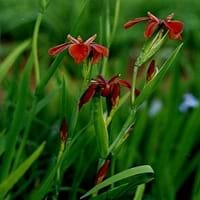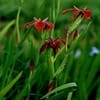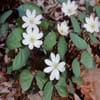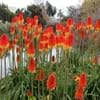Life Span
Perennial
Perennial
Origin
Southeastern United States, South-Central United States
Hybrid origin, Mexico, Central America, South America
Types
Apricot Queen, August Flame, Autumn Fire
Not Available
Habitat
Fields, marshes, Swamps
Coastal Regions
USDA Hardiness Zone
6-11
11-15
AHS Heat Zone
Not Available
12-1
Sunset Zone
H1, H2, 3a, 3b, 4, 5, 6, 7, 8, 9, 10, 11, 12, 13, 14, 15, 16, 17, 18, 19, 20, 21, 22, 23, 24
A1, A2, A3, H1, H2, 1a, 1b, 2a, 2b, 3a, 3b, 4, 5, 6, 7, 8, 9, 10, 11, 12, 13, 14, 15, 16, 17, 18, 19, 20, 21, 22, 23, 24
Habit
Clump-Forming
Upright/Erect
Flower Color
Orange, Dark Red, Orange Red, Copper, Chocolate, Black
Yellow
Flower Color Modifier
Bicolor
Bicolor
Leaf Color in Spring
Green
Green, Dark Green
Leaf Color in Summer
Green
Green, Dark Green
Leaf Color in Fall
Green
Green, Dark Green
Leaf Color in Winter
Light Green
Green, Dark Green
Leaf Shape
Long Linear
Ovate
Plant Season
Spring
Spring, Summer, Fall
Sunlight
Full Sun, Partial Sun
Full Sun
Type of Soil
Clay, Loam, Sand
Loam, Sand
The pH of Soil
Acidic, Neutral, Alkaline
Neutral
Soil Drainage
Poorly Drained
Well drained
Bloom Time
Spring, Late Spring
Indeterminate
Tolerances
Drought
Drought
Where to Plant?
Container, Ground, Pot
Container, Ground
How to Plant?
From Rhizomes, Seedlings
Grafting, Seedlings
Plant Maintenance
Medium
Medium
Watering Requirements
Do not let dry out between waterings, Needs Very high moisture
Needs more water during establishment
In Summer
Lots of watering
Lots of watering
In Spring
Moderate
Moderate
In Winter
Average Water
Average Water
Soil pH
Acidic, Neutral, Alkaline
Neutral
Soil Type
Clay, Loam, Sand
Loam, Sand
Soil Drainage Capacity
Poorly Drained
Well drained
Sun Exposure
Full Sun, Partial Sun
Full Sun
Pruning
Remove damaged leaves, Remove dead branches, Remove dead leaves
Pinch or prune as they grow to promote branching and bushiness
Fertilizers
organic fertlizers
14-14-14 Fertilizer, Compost
Pests and Diseases
Mosaic potyvirus
Anthracnose, Aphids, Red blotch, Rust
Plant Tolerance
Drought
Heat Tolerance, Salt and Soil Compaction
Flower Petal Number
Single
Single
Fragrant Bark/Stem
No
Yes
Foliage Texture
Medium
Medium
Foliage Sheen
Matte
Matte
Attracts
Butterflies, Hummingbirds
Aphids, Not Available, Squirrels
Allergy
Poisonous to grazing animals
Stomach pain, Vomiting
Aesthetic Uses
Bog Garden, Water gardening
Used in parkland
Beauty Benefits
Not Available
Anti-ageing, Blackheads, Reduce Bruises
Environmental Uses
Air purification
Shadow Tree, Soil protection
Medicinal Uses
Sedative
Dehydration, Diabetes, Diarrhea, Nutrients, Weight loss
Part of Plant Used
Flowers
Fruits
Other Uses
Oil is used for aromatherapy
Application in Handicrafts, Food for animals, Showy Purposes
Used As Indoor Plant
No
No
Used As Outdoor Plant
Yes
Yes
Garden Design
Bog Garden, Water Gardens, Wildflower
Edible, Herb, Vegetable
Botanical Name
IRIS fulva
Manilkara zapota
Common Name
Copper iris
sapodilla , chikoo, Sapota
In Hindi
Copper Iris
चीकू
In German
Copper Iris
Breiapfelbaum
In French
Copper Iris
Sapotillier
In Spanish
Cobre Iris
chicle
In Greek
χαλκός Iris
sapodilla
In Portuguese
Copper Iris
sapodilla
In Polish
Miedź Iris
Pigwica właściwa, sapodilla
In Latin
Iris Copper
sapodilla
Phylum
Magnoliophyta
Magnoliophyta
Class
Liliopsida
Magnoliopsida
Family
Iridaceae
Sapotaceae
Clade
Angiosperms, Monocots
Angiosperms, Asterids, Eudicots
Subfamily
Iridoideae
Sapotoideae
Number of Species
Not Available
Importance of Copper Iris and Sapodilla
Want to have the most appropriate plant for your garden? You might want to know the importance of Copper Iris and Sapodilla. Basically, these two plants vary in many aspects. Compare Copper Iris and Sapodilla as they differ in many characteristics such as their life, care, benefits, facts, etc. Every gardener must at least have the slightest clue about the plants he wants to plant in his garden. Compare their benefits, which differ in many ways like facts and uses. The medicinal use of Copper Iris is Sedative whereas of Sapodilla is Dehydration, Diabetes, Diarrhea, Nutrients and Weight loss. Copper Iris has beauty benefits as follows: Not Available while Sapodilla has beauty benefits as follows: Not Available.
Compare Facts of Copper Iris vs Sapodilla
How to choose the best garden plant for your garden depending upon its facts? Here garden plant comparison will help you to solve this query. Compare the facts of Copper Iris vs Sapodilla and know which one to choose. As garden plants have benefits and other uses, allergy is also a major drawback of plants for some people. Allergic reactions of Copper Iris are Poisonous to grazing animals whereas of Sapodilla have Stomach pain and Vomiting respectively. Having a fruit bearing plant in your garden can be a plus point of your garden. Copper Iris has no showy fruits and Sapodilla has showy fruits. Also Copper Iris is flowering and Sapodilla is not flowering . You can compare Copper Iris and Sapodilla facts and facts of other plants too.





